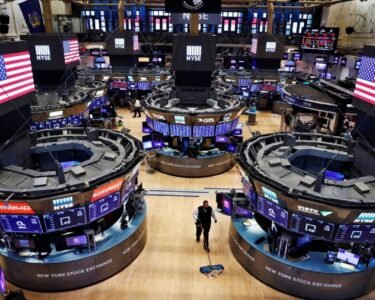There is a small number of assets and firms that continue to resist the growing uncertainty caused by tariffs imposed by U.S. President Donald Trump.
Two of them demonstrated their resilience this week by marking a new all-time high and becoming the only company that reached a market valuation above $4 trillion. Yes, we are talking about bitcoin and chipmaker Nvidia.
In a highly volatile market dynamic, bitcoin on Friday topped $118,000 for the first time, in what analysts described as a response to the friendly policies of the new Trump administration for digital assets and stablecoins.
At the same time, this past week was marked by Nvidia, which on Wednesday made history by hitting $4 trillion mark, once again cementing its role as the bellwether of the artificial intelligence boom.
Both developments come despite global headwinds and the onset of the introduction of steep levies that put many companies, individuals and broader economies at risk. Tariffs have also resulted in the worst first half of the year for the U.S. dollar since at least 1973.
The main catalyst behind the meteoric rise of Nvidia is undoubtedly the adoption of AI and high demand for its advanced graphics processing units (GPUs), which are seen as a “must-have” by companies developing large language models (LLMs), data centers and new software.
Only a year ago, in spring of 2024, the company based in Santa Clara, California, managed to eclipse Saudi oil giant Saudi Aramco to become, at the time, the world’s third most valuable firm. Fast forward one year and Nvidia sits ahead of Microsoft and Apple, while Aramco dropped to seventh place on the list.
At the same time, a quick look at the table reveals that the market valuation of Nvidia is almost as much as the value of Alphabet ($2.19 trillion) and Meta Platforms ($1.8 trillion) combined.
Valued at close to $165 per share, the chipmaker, led by Jensen Huang, is seen as one of Wall Street’s most-favored stocks. Despite certain ups and downs, such as when the launch of DeepSeek shook the entire U.S. stock market, Nvidia has seen a steady rise in the past couple of years, and investors remain largely bullish on the stock.
However, the company also remains one of the sticky points in tech tensions between the U.S. and China, as Washington, by curbing shipments of its most advanced chips, looks to solidify the perceived lead in the artificial intelligence sector.
This week, Huang is visiting Beijing and ahead of the trip, he met Trump. What was on the agenda between the two men is unclear, Bloomberg reported.
The meeting still underscores the high stakes of the company itself and comes as Huang earlier acknowledged the importance of the Chinese market for Nvidia.
Since 2022, the U.S. government has imposed restrictions on the export of Nvidia’s most advanced chips to China, citing concerns over potential military applications.
The U.S. also imposed a ban earlier this year on sales of Nvidia’s H20 artificial intelligence chips to the country, which had been Nvidia’s most powerful AI chip cleared for Chinese sales.
The company, for now, managed to weather the impact of the curbs and tariffs as it continued to boost revenues in the first quarter of the year. In contrast, the companies in many other sectors, including automotive and the retail industries, flagged the impact of tariffs, sometimes pointing to losses amounting to billions of dollars.
Huang has dubbed AI “the next industrial revolution,” and Nvidia’s GPUs are designed to perform artificial intelligence tasks faster and more efficiently than general-purpose chips like CPUs.
Bitcoin run
Similarly, this week, bitcoin, amid soft dollar outperformed expectations, climbed to as high as $118,856 early Friday. The world’s most popular cryptocurrency later fell slightly under the $118,000 mark and still close to this level as of Sunday afternoon.
Spot bitcoin ETFs opened up cryptocurrency investing more widely after launching last year – and analysts have pointed to record inflows recently.
Last month, the U.S. Senate also passed legislation that would regulate a form of cryptocurrency known as stablecoins, the first of what the industry hopes will be a wave of bills to bolster its legitimacy and reassure consumers.
Known as the GENIUS Act, the bill would establish guardrails and consumer protections for stablecoins, a type of cryptocurrency typically pegged to the U.S. dollar. The acronym stands for “Guiding and Establishing National Innovation for U.S. Stablecoins.”
The fast-moving legislation comes on the heels of a 2024 campaign cycle in which the crypto industry ranked among the top political spenders in the country.
Bitcoin’s rise also arrives amid a wider backdrop of economic uncertainty, notably the global turmoil spanning from Trump’s on and off tariffs imposed against key trading partners worldwide.
“Bitcoin has shown resilience this year rebounding in-line with its macro exposures following tariff announcements,” Citi analysts wrote in a Friday research insight.
But again, they noted that the Trump administration “has been positive for Bitcoin” overall, and attributed bitcoin’s recent rally to overall changes to the outlook of U.S. regulation, as well as investments into spot ETFs.
Bitcoin’s backers have often argued that the asset is like a “digital gold” that can act as a hedge against volatility, but many have remained skeptical of that comparison. Larger market conditions have also previously proven to sway bitcoin’s price.
In April, amid a wider selloff following Trump’s sweeping “Liberation Day” tariff announcements, bitcoin briefly dipped below $75,000. That marked the cryptocurrency’s lowest price since before Trump’s Election Day victory in November.
While bitcoin has since rebounded significantly, it’s important for investors to remember that it’s still a highly volatile and relatively new asset that has seen wild swings in value before.





